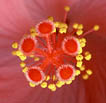| An Introduction to Microscopy |
Under the stereo microscope these tiny flowers will be huge and can be seen in three dimensions. |
|
| Botany | ||
Botanical objects are of special interest for the beginner in microscopy. Interesting material can be found anywhere around you, even in the living room. No difficult preparations are needed, you can start by looking at a whole flower, leaf or root under the stereo microscope. Click the thumbnail to see examples of how flowers look under the stereo microscope |
||
To be able to see the cell structure of plants you need instead of a stereo microcope a microscope with stronger magnification and transmitted light. You have to make thin sections (Coupes) because the microscope works with incident light. The section has to be thin enough for the light to pass. These sections are not difficult to make but it requires some skill to make such thin sections that you see one or two layers of cells. Use a razor blad to cut a thin slice. A good way is to hold the razor in one hand and cut by rotating the stem of a plant. If you don't want to mess with razors there is a very simple solution to get thin plant samples. In every garden you can find mosses. Their leaves are only one cell thick and will show many interesting features under the light microscope, without more preparation than adding a drop of water and putting a coverslip on top. Especially rewarding are the leaves of Sphagnum, mosses that you can find in marshes. Many empty cells in the leaves can hold a lot of water and that is why Sphagnum is often used in flower shops. Under the stereo microscope the spore capsules of mosses are interesting and beautiful. For the serious mycologist (mycology is the study of Fungi) a microscope is a must. Many of these LBM's (little brown mushrooms) can only be determined by making a spore figure and looking at the spores, in most cases with high magnification. And in many other mushrooms you have to make a squash preparation of a small part of a gill, to look at the shape of the cystidia (sterile cells). And do not forget to look at a squash preparation of a small section of an Orange Peel Fungus (Aleuria aurantia) or the Eyelash Fungus (Scutellinia scutellata), with the spores (8) lying in a small sac. If you are not allergic, try ripe grasses under the stereo microscope. You can also study the plants pollen. Pollen is very small so you need the 40X objective of the microscope. |
||

